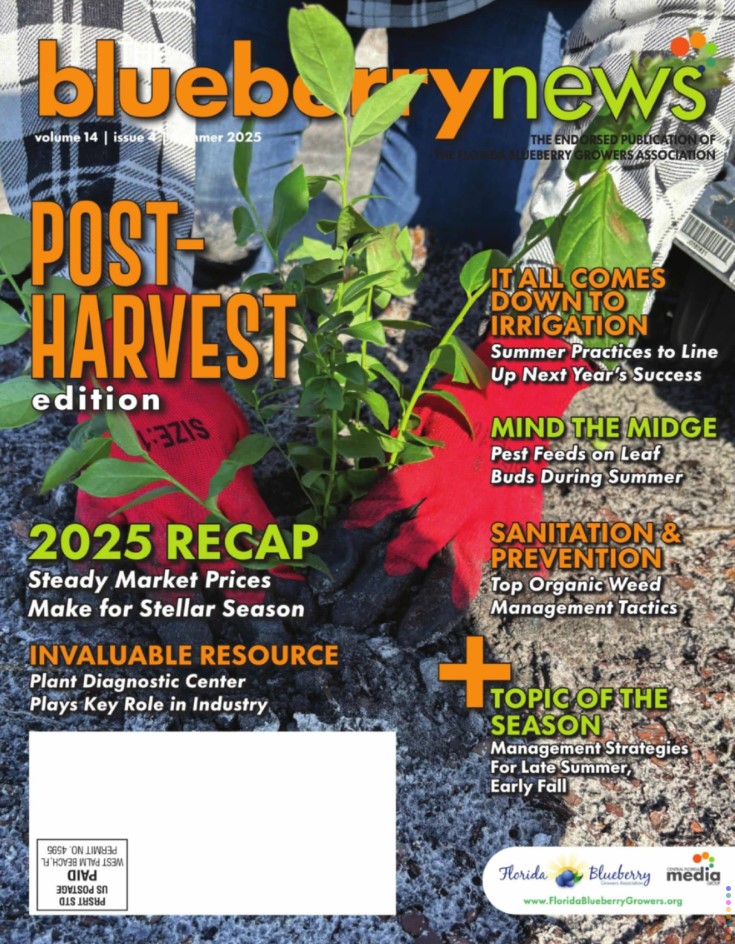Bacterial Wilt of Blueberry Caused by Ralstonia Solanacearum
Researchers share Initial Findings of Disease and What to Do if Detected in Your Crops
width="300"] Figure 1[/caption]
Figure 1[/caption]
The latest disease threat to Florida blueberries is bacterial wilt caused by Ralstonia solanacearum. The disease was first found in the state last year on a handful of farms from Alachua to Hendry County. Many questions arose about why now, where it came from, and what to do about it. Good quality research takes money, time, peer review, and then publication of the results . . . Those results are used to develop recommendations from the Extension lab to deal with the problem. This is going to take a while. In the meantime, let’s review what we know, what we’ve learned (in about 6 months), and what we can guess it means for management options today, as well as tomorrow. We have a lot of research underway here at UF, and a lot more planned, pending funding.
The disease was initially found on the UF variety Arcadia, but has since been confirmed in Avanti, Kestrel, and a non-UF proprietary variety as well. This indicates that the problem is going to be more than an Arcadia-specific issue. The Avanti and Kestrel finds were on farms where the disease was first confirmed on Arcadia. This may mean that Arcadia is going to end up being more susceptible than some other cultivars. Growers have asked if they should plant Arcadia back where Ralstonia killed them. One of my Ph.D. students, Ms. Deanna Bayo, is working to inoculate rooted cuttings of all currently available UF varieties in greenhouse experiments to try to find out which, and how susceptible, today’s options are. This is work in conjunction with Dr. Munoz and the breeding program with eyes forward to ultimately developing a screen for selection of resistant varieties.
SO, WHERE DID THIS THING COME FROM?
Dr. Dave Norman, UF MFREC Apopka, has cranked out a tremendous amount of work in a short time to try to help us answer that question. The results are providing important answers! Dr. Norman has been able to cobble together carry over funds, and has included our blueberry isolates as part of ongoing grant-funded projects in his lab to get preliminary data. I will be doing everything I can to make sure we can find big competitive funding to keep that work going, and to expand his interest/involvement in the blueberry system. As an Extension specialist, I need Dr. Norman’s research collaboration and expertise— Florida blueberry growers need this too.
[/fusion_builder_column][fusion_builder_column type="1_1" background_position="left top" background_color="" border_size="" border_color="" border_style="solid" spacing="yes" background_image="" background_repeat="no-repeat" padding="" margin_top="0px" margin_bottom="0px" class="" id="" animation_type="" animation_speed="0.3" animation_direction="left" hide_on_mobile="no" center_content="no" min_height="none"][caption id="attachment_3035" align="alignleft" width="300"] Figure 2[/caption]
Figure 2[/caption]
WHAT ARE OUR CURRENT FINDINGS?
What we’ve found so far is not what was expected and has already impacted our recommendations. In most historical cases, new Ralstonia outbreaks can be traced to a single source of pathogen like a greenhouse or nursery. Initially, the Arcadia plants that were positive did come from a single nursery source. A survey by FDACS DPI did not find the nursery to have a widespread Ralstonia problem as expected. Dr. Norman’s research confirmed that the pathogens found on the various farms were not genetically the same Ralstonia. They were diverse and have likely been on those farms for years. Cooperation between research, Extension, and regulatory, in this case, ruled out a potential source, rather than jumping to a conclusion that could have had significant regulatory impact on the nursery’s business.
Ralstonia has been in Florida for a long time. So why now? Why these farms? I don’t have a satisfactory answer and that bothers me. We’ve asked many questions and looked for similarities between farms, but haven’t seen any obvious trends. One consistency is that the disease has occurred only on blueberries grown in evergreen production. Whether that has anything to do with it is unknown at this point, but evergreening does put plants under unique stresses. In our inoculation experiments, both Dr. Norman and I have noted that plants take longer to develop symptoms than we expected them to. About 90 percent of tomato plants can be killed in a week or two when inoculated with Ralstonia. Blueberries can take four to six weeks to show symptoms, and more than 10 percent won’t develop symptoms at all. This may suggest that the pathogen is not a particularly good blueberry killer, and that disease may require some specific stresses or environmental conditions to develop. If that sounds familiar, think stem blight. It may also mean that the pathogen has a hard time infecting blueberry roots on its own without being moved plant to plant by pruning tools. Managing irrigation, fertility, pruning practices, and all the other horticultural inputs to try to prevent plant stress, will pay extra dividends in preventing or reducing plant disease.
[/fusion_builder_column][fusion_builder_column type="1_1" background_position="left top" background_color="" border_size="" border_color="" border_style="solid" spacing="yes" background_image="" background_repeat="no-repeat" padding="" margin_top="0px" margin_bottom="0px" class="" id="" animation_type="" animation_speed="0.3" animation_direction="left" hide_on_mobile="no" center_content="no" min_height="none"][caption id="attachment_3036" align="alignright" width="300"] Figure 3[/caption]
Figure 3[/caption]
MANAGING THE DISEASE
Other options for managing the disease are outlined in our EDIS publication found at edis.ifas.ufl.edu/pp332. Once the disease is confirmed on a farm, the only labeled chemical treatment option is an injection of a phosphorous acid product through irrigation. This has reduced disease in ornamental and vegetable crops, and is allowed on some current product labels. One example mentioned in the EDIS publication is K-Phite, which is legal to apply to blueberries and has Ralstonia as well as through-irrigation and drench application on the label. Several growers have asked about using other similar products. As long as the site, application method, and crop plant are on the label, and as long as that particular use is not prohibited on the label, then it’s legal to use it. No products have this disease specifically for blueberry (since it’s a new disease), and there is no expectation of efficacy. So basically, we don’t know how well this will work, for how long, or what the long term implications are. We really need research to get those answers, and we are planning to start in the greenhouse, and then move to the field to test these methods. We plan to also test a few other options not currently labeled for use on blueberries. I’ve overheard talk about some growers considering using products labeled for citrus illegally. DON’T DO IT. Let UF test them, and we will get the labels if they work and are safe.
[/fusion_builder_column][fusion_builder_column type="1_1" background_position="left top" background_color="" border_size="" border_color="" border_style="solid" spacing="yes" background_image="" background_repeat="no-repeat" padding="" margin_top="0px" margin_bottom="0px" class="" id="" animation_type="" animation_speed="0.3" animation_direction="left" hide_on_mobile="no" center_content="no" min_height="none"][caption id="attachment_3037" align="alignleft" width="238"] Figure 4[/caption]
Figure 4[/caption]
WHAT ELSE CAN WE DO?
Well, we don’t know what is going to happen this summer in terms of disease development. The best thing to do is to keep scouting fields regularly, send samples to the UF Plant Diagnostic Center if you see symptoms like those described in the EDIS publication. We need to know how widespread the disease is, and whether or not it gets more severe this year on farms that already have lost plants. These observations, as well as results from our continued research, will be relayed to update FBGA members through future articles, and Extension presentations, so stay tuned.
Here is an overview of symptoms of bacterial wilt on blueberry taken from the EDIS publication edis.ifas.ufl.edu/pp332: wilting and marginal leaf burn (Figure 1 and 2); a mottled discoloration or light brown to silvery purple blotches with ill-defined borders (Figure 3); bacterial ooze streaming from crown wood chips floated in water (Figure 4); and large circular patches of dead and dying plants (Figure 5 and 6).
[/fusion_builder_column][fusion_builder_column type="1_1" background_position="left top" background_color="" border_size="" border_color="" border_style="solid" spacing="yes" background_image="" background_repeat="no-repeat" padding="" margin_top="0px" margin_bottom="0px" class="" id="" animation_type="" animation_speed="0.3" animation_direction="left" hide_on_mobile="no" center_content="no" min_height="none"][gallery columns="2" size="medium" ids="3039,3038"]
Direct questions concerning bacterial wilt to the state blueberry pathology extension specialist Dr. Philip Harmon: (352) 273-4622 or email [email protected]
Diagnostic Center website:
plantpath.ifas.ufl.edu/extension/plant-diagnostic-center/
The form:
plantpath.ifas.ufl.edu/media/plantpathifasufledu/plant-disease-clinic/PDC_Submission_form_CC-1.19.16.pdf)
Plant Diagnostic Center
UF-IFAS Plant Diagnostic Center
Bldg. 1291, 2570 Hull Road
Gainesville FL 32611
352-392-1795
[email protected]
CREDIT
by Philip F. Harmon, UF/IFAS Extension Blueberry Plant Pathologist[/fusion_builder_column][/fusion_builder_row][/fusion_builder_container]





